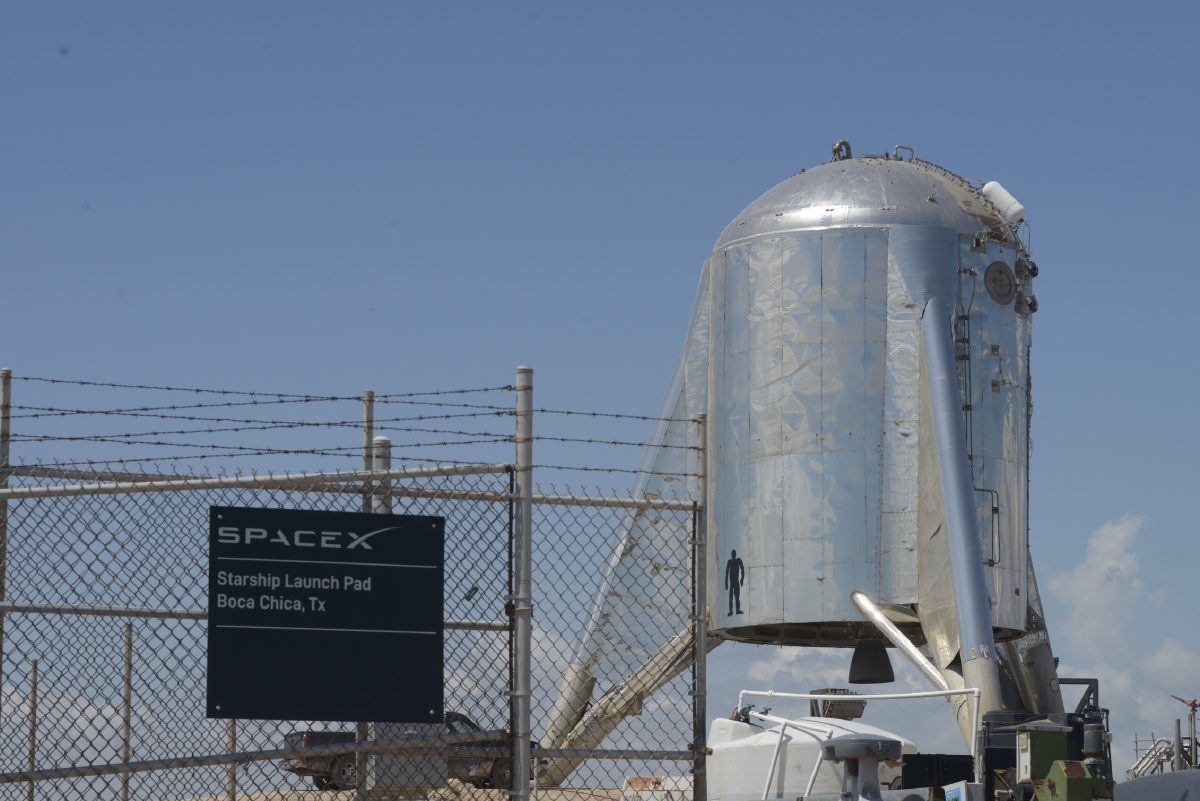SpaceX’s first untethered launch of its Starhopper prototype at Boca Chica Beach late Thursday was an important milestone for the company and development of the 100-passenger Starship/Super Heavy vehicle SpaceX plans to take to the Moon and Mars.
The hopper’s single Raptor rocket engine ignited at 10:44 p.m. at the launch/test site 24 miles east of Brownsville, enveloping the stainless-steel-clad vehicle in billowing fire and exhaust before pushing it upward and to one side before the hopper touched down again. The test ignited a brush fire that continued to burn Friday.
In drone footage posted by SpaceX CEO Elon Musk on Twitter early Friday morning, the hopper can be clearly seen ascending, atop a column of blue flame, before disappearing completely behind orange-tinted clouds of exhaust. In footage from a camera mounted to the bottom of the hopper, the engine can be seen igniting and the vehicle rising and moving over the launch pad, with quick minor adjustments of the engine’s attitude to maintain control, before setting down.
In a nod to the many commentators noting the hopper’s resemblance to a water tower, Musk tweeted a few minutes after the inaugural flight: “Starhopper flight successful. Water towers ‘can’ fly haha!!”
The flight took place after an aborted hop attempt on July 24, caused by excessive pressure due to colder-than-expected propellant, according to Musk. The goal had been to fly the hopper to 20 meters, or about 65 feet. SpaceX, based in Hawthorne, Calif., hasn’t indicated whether the vehicle reached that height Thursday, though Musk tweeted that the next step is a 200-meter hop (just over 656 feet) within the next week or two.
SpaceX hopes to have its Mark 1 version of Starship, now under construction at SpaceX’s Boca Chica yard near the launch site, ready for testing up to 20 kilometers, or 12.4 miles, in a few months, Musk wrote in a July 12 tweet.
The Mark 1 will fly with three Raptor engines compared to the Starhopper’s one. The same is true for the Mark 2 Starship version being built at Cocoa, Fla., near Cape Canaveral. Both versions are much more spaceship-like in appearance than the 60-foot-tall hopper, whose stubby build earned it the water tower comparisons.
Thursday’s hop, an important event for SpaceX, was likewise a milestone for Brownsville in its pursuit of space-related economic development, a dream sparked by the company’s announcement that it planned to build a launch facility at Boca Chica.
The dream was not, and is not, universally embraced, as some residents of Boca Chica Village near the launch site and environmentalists voice concerns about quality of life and the effect on wildlife and the environment.
The city first learned in early 2011 it was in the running for what SpaceX intended at the time as the world’s first commercial spaceport. In September 2014, a ceremonial groundbreaking took place at Boca Chica, with Musk and then-governor Rick Perry in attendance. Then not much happened for a while.
A process of soil “surcharging” began in late 2015 and entailed construction of an artificial plateau containing 310,000 cubic yards of dirt, the purpose being to raise and stabilize the site for launch operations. Next the company brought in two enormous ground-station antennas for tracking space flights and installed a 600-kilowatt solar array to power them. Eventually, tanks for methane and liquid oxygen — the propellants used to fuel the Raptor engine — were delivered to the site. A hangar was erected.
In December, Musk tweeted photos of the Starhopper under construction at Boca Chica. The prototype’s first two tethered engine static fire tests took place in early April as a run-up to Thursday’s hop, which relied on an improved design of the Raptor engine used in April.
SpaceX’s original vision for Boca Chica was as an orbital rocket launch site meant to accommodate 12 commercial launches a year, though during the groundbreaking Musk suggested it could also some day serve as the departure point for the first manned flight to Mars. His ultimate goal is for humans to colonize the Red Planet to ensure survival of the species.
The groundbreaking happened years before the first launch of the company’s massive Falcon Heavy rocket, the success of which put SpaceX on the path to developing the even bigger Starship/Super Heavy as its Mars rocket, not the Falcon Heavy as originally planned.
Since 2014, the company’s plans for Boca Chica appear to have evolved as the site has become a construction and testing ground for Starship prototypes as opposed to a commercial spaceport — at least for the time being. In any case, the company’s hopper tests have put Boca Chica, Brownsville and the Lower Rio Grande Valley in the global spotlight as never before, and local leaders hope to capitalize on the situation by building a “new space” economy around SpaceX.
Gil Salinas, for one, is pinching himself. As former executive vice president of the now-defunct Brownsville Economic Development Corporation, he was in conversations with Musk and his team from the beginning, when SpaceX was still basically a startup company with just a handful of successful launches under its belt.
That was before SpaceX became the first commercial space venture to dock with the International Space Station, in 2012, and the first company to successfully land an orbital rocket following reentry, in late 2015.
Salinas characterized Thursday’s hop as an “historic moment for the space sector.”
“I got chills running down my spine, because I remember Elon Musk talking about the great possibilities an area such as Boca Chica had as it pertained to space flights,” he said. “It was 2011, during the economic downturn. We were in Hawthorne, Calif., and had no idea then that we were meeting with one of the greatest innovators and visionaries of our time.”
The talk these days isn’t about “if” humans will get to Mars, but rather “when,” Salinas said.
“When the first person lands on Mars, we’ll be able to point to 2011 as the year that Brownsville met with Elon about his plans to colonize Mars,” he said. “It’s historic in so many ways.”






